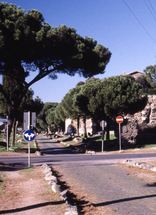Ancient World Seminar 2009

(Photograph: Andrew Stephenson)
Papers for 2009
17 March
Louise Hitchcock, University of Melbourne
In the Wake of the Sea Peoples/In the footsteps of Goliath: 2008 season of the University of Melbourne excavations at Tell es-Safi/Gath
In 2006, the University of Melbourne became involved with the ongoing Bar-Ilan University excavations at Tell es-Safi, ancient Gath, the largest of five cities of the Philistines, located mid-way between Jerusalem and Ashkelon. Among the key discoveries from Tell es-Safi are the earliest Philistine inscription, mentioning the Indo-European names Alyattes and Wylattes, linguistically similar to “Goliath.” Tell es-Safi/Gath has architecture, pottery and dining habits attested in Greece and Cyprus. Our collaboration aims to discover how material culture can contribute to the understanding of Philistine civilization in its wider Mediterranean context. Tuesday’s talk will focus specifically on the Melbourne team’s discoveries in 2008 and discuss opportunities for students in 2009.
24 March
Helen Slaney, Monash University
Liminal’s Kosky’s Hughes’s Artaud’s Seneca’s Oedipus
31 March
Andrew Madden, University of Melbourne
Church Mosaic Pavements in Byzantine Palestine: An overview of pattern types and distribution
7 April
Jessie Birkett-Rees, University of Melbourne
Archaeological Landscapes of Transcaucasia
21 April
Josephine Verduci, University of Melbourne
The Minoan Costume and Body Modification in Antiquity
28 April
Andrew Kelly, University of Melbourne
People Came Running: Street Crowds Under the Athenian Democracy
5 May
Frederick Bendeich, University of Melbourne
The Scepticism of Herodotus
12 May
Norman Yoffee, Michigan University
The Earliest Cities and the Evolution of History
26 May
Alexander Weiss, Universität Leipzig
The Invention of a Myth in Sallust: The African History Account of King Hiempsal II of Numidia
11 August
Sean Byrne, University of Melbourne
Damn the Macedonians: The Athenian Damnatio Memoriae of the Antigonids of 200 B.C.
18 August
Peter Mathews, Latrobe University
Maya hieroglyphs and their Decipherment
25 August
Stevie Schafer, University of Melbourne
‘I thought exile was a punishment, but now I see it’s a gift!’: Exile and dwelling in Seneca’s Medea
Seneca’s Medea, arguably, is a tragedy of exile. After leaving her home, the heroine finds herself an exile. This theme is more prominent in Seneca’s Medea than Euripides’. This paper contends that Seneca’s play engages with the foundation myth of Aeneas through allusion to the Aeneid. Seneca’s tragedy explores the exilic state in such a way that engages with Rome’s mythical history. The exilic myth of Aeneas is not only evoked in this tragedy but also disclosed to the audience in a way that forcefully and provocatively navigates important facets of this myth. This paper explores some of the aspects of the theme of exile and dwelling in Seneca’s Medea to uncover the complex ambiguities, mythically articulated, of the Roman condition.
1 September
Derek Welsby, British Museum
Excavations at the Town and Cemetery at Kawa
Since 1993 the Sudan Archaeological Research Society, supported by the British Museum, has been undertaking survey and excavations at Kawa and in its hinterland. Work has been focussed on the Kushite period remains and this has demonstrated that Kawa was a large and important centre for over 1000 years. Following on from a detailed topographical survey a number of areas of the town have been investigated in detail including a shrine, domestic housing and an industrial quarter. In the associated cemetery graves of a range of types have been excavated covered by tumuli, mastaba and pyramids. Very extensive collections of artefacts, particularly from the earlier Kushite period, have been recovered which will be an important resource for understanding the chronology particularly of the ceramic material. The excavation of a well-preserved town and its associated cemetery is providing an excellent opportunity to reconstruct many aspects of life at Kawa between the early 1st millennium BC and the 4th century AD.
6 October
Jason Adams, University of Melbourne
Dominus et Deus aedificatorum: Domitian, the ‘Lord and God’ of Builders
13 October
Brent Davis, University of Melbourne
Introduction to the Cypro-Minoan Script
20 October
William Anderson, University of Melbourne
Roman Backwater, Byzantine Frontier: Material Culture in a Marginal Landscape
The site of Euchaita in the Pontic hinterland of north-central Anatolia has attracted considerable interest on account of its religious and military history. From the 4th century, Euchaita was the cult centre of the martyr St Theodore the Recruit; in the early 6th century it attained metropolitan status; and in the 7th century it was the target of Sassanian and Arab military raids. With such a weight of historical evidence it is tempting to let the written record guide interpretation of the material remains, yet such an approach may detract from other forms of information - on settlement patterns and demographics, agricultural production, trade and social networks, and political and cultural identity. In this paper I will discuss archaeological evidence gathered by the Avkat Archaeological Project - a contemporary, multi-disciplinary survey and research project - focusing on material culture in the Roman and Late Roman periods.
27 October
Sonya Wurster, University of Melbourne
Philodemus and the Construction of Greek Identity
22 December
Benjamin Lazarus, Linacre College, Oxford
A Funny Way of Looking at Things in Ancient Literature